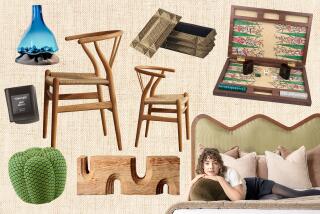The Nouveau Dish
In a new Lenox china ad, a twentysomething couple in jeans sit on a floor strewn with cardboard boxes in a room lit only by candlelight. White linen napkins draped over an oblong box create a decidedly makeshift yet oddly fashionable tablecloth. The box showcases two bone china plates filled with Chinese vegetables dispensed from a nearby carton.
The festive (albeit eclectic) effect is both formal and informal, the quintessential â90s hybrid of casual and elegant, complete with a cynical tribute to style over substance. (Who cares if you donât make the food as long as it can be bought and served with savoir-faire?)
Had it not been for the imagination of retailers, manufacturers and decorators, china might easily have gone the way of hats for men and gloves for women, both quaint reminders of the formality of yesteryear. But for the moment civility remains a part of setting up house, thanks to innovative table settings, nouveau china patterns and the return of cocooning, widely viewed as responsible for a resurgence in home entertaining.
Some things donât change: Wedding registries are still responsible for the lionâs share of china purchases. About 75% of all fine china and dinnerware sold in the United States is purchased by or for registered brides, said Annie Thurow, director of research for Modern Bride magazine.
Some things do change: Nearly 80% of brides registering at Bloomingdaleâs Southern California stores bring their grooms along when selecting patterns, said Anne Fahey, regional merchandise manager / home division.
And among the vast array of china and tabletop accessories available, more stores are carrying the names of such famed fashion designers as Gianni Versace, Christian Lacroix and Calvin Klein.
Whatâs the Dish?
The selection has become mind-boggling.
At Gearyâs alone, betrothed browsers may choose from about 600 patterns of dinnerware ranging from everyday place settings to hand-painted china costing $1,200 for a single salad plate.
And although china remains a fundamental part of a brideâs registry, the image of the pearl-clad wife in the pressed cotton dress waltzing around a table set formally for dinner guests is more the stuff of Nickelodeon reruns than contemporary reality.
The way china is being used is changing.
âPeople today are entertaining more casually, so theyâre using their china in a different way,â said Carolyn Bartel, tabletop / decorating editor for Modern Bride magazine. Bartel said itâs especially trendy for brides to mix everyday dinnerware with china, especially when trying to achieve as individual a look as possible.
Such an approach is ideal for those people who âfeel that crystal and china are too off-putting for dinner on the deck or a sit-down dinner on a cocktail table,â Bartel said. A bride, she explained, might register for dinner plates from one line, salad plates from another and then maybe mix the two with something she inherited from her grandmother.
Fahey said manufacturers are capitalizing on the trend by creating lines that complement their existing patterns. Bernardaudâs Louve, Bloomingdaleâs most popular pattern, is easily paired with several other patterns for varied looks.
Geri Morguelan, who has been registering brides for more than four years at Neiman Marcus Beverly Hills, said the secret to achieving a successful mix of patterns is to stay within the same color family.
âThe dinner plate usually has a solid border, gold or platinum, while the salad or dessert [has] a different motif with a complimentary color but with varying degrees of opacity and texture. When itâs done right, it makes for a very colorful table,â she said.
Rita Gold, store manager at Gearyâs Beverly Hills, agrees that color is the common denominator when going for an eclectic effect. For instance, one place setting featured inside one of Gearyâs many tabletop vignettes includes a Havilland Safran porcelain charger in a rich saffron shade topped with a Maldives Philippe Desholieres dinner plate with a tropical motif that includes shades of celadon, azure and fuchsia. Desholieresâ Carabes salad plate sits atop the dinner plate. The crowning touch: a small crystal open salt (a quaint non-shaker device) filled instead with cocktail nuts.
The trendiest colors in china patterns are popular in current fashion. Citrus greens, yellows and oranges were among the newest shown at the Tabletop Market in New York City earlier this year. Bloomingdaleâs Fahey said platinum and silver bands are outselling the gold, and black as an accent color is quite popular now.
Mixing and matching strategies have practical applications too. Brides on a budget can register for single plates of more expensive chinas and fill out their place settings with more affordable salad plates. It also comes in handy, Gold said, for making use of the occasional pieces that survive earthquakes when others in a set do not.
Brides registering at Neiman Marcus are blending Annieglass, a tempered glass plate made in California, with their china. The translucence of the glass plates is best offset by a heavily patterned, highly ornate china, like that created by Versace, which is especially popular with celebrities, Morguelan said.
While many stores report that designer patterns are in general no more popular than others, Bloomingdaleâs reported increased sales (including one approaching $4,000) following the July slaying of Versace outside his Miami home.
Among the fashion designers offering lines of china are Ralph Lauren and Lacroix. (Kleinâs dinnerware, featuring the designerâs trademark simplicity, is considered an everyday pattern.) Another famous design name, that of architect Frank Lloyd Wright, graces the shelves at Tiffany & Co.
The Negotiations
*
âYou donât like it. You wouldnât even enjoy food served off it,â joked groom-to-be Jonathan Rodgers, standing in Gearyâs Beverly Hills with fiancee Diana Kreinman in front of a Lenox china place setting, a potential candidate for their bridal registry.
They laughed lightly and walked on. But the search for the perfect place setting sometimes involves diplomatic dialogue and partnership--a difference from customs of decades past.
It used to be that most brides and their mothers selected the china, while the groom simply nodded in detached approval. On a recent Thursday, Rodgers and Kreinman met after work at Gearyâs for Round Two of china selection. Kreinman, in the pinstripes pantsuit from her job as an insurance defense attorney, clutched files and bridal magazines. Sheâs more than done her homework: All are painstakingly earmarked with legal paper fragments.
She led the overview tour. Wedding talk may be fun--even if the Four Seasons Beverly Hills gala for 300 guests is eight months off--but this was business.
Round One of china selection, an hour and a halfâs worth, had yielded what both perceived as a winner: Bernardaudâs Paris pattern, which sells for $350 for a four-piece place setting. But on closer examination, next to the crystal and silver they selected to match it, a mutual veto reopened negotiations. During this round, Kreinman and Rodgers were to assemble all tabletop components to ensure place setting harmony (and presumably marital harmony) before they signed off on any one item.
Kreinman spotted a contender. Price: $2,800 a place setting. Her face showed a âyikesâ expression. âA bargain,â Rodgers quipped in disbelief. The two giggled and moved on.
Rodgers offered remarks ranging from âthat wouldnât be my first choiceâ to âno butterflies and bugs.â He learned that Kreinman doesnât want âtoo much goldâ or âtoo much green.â
âI havenât been able to figure that whole green thing out,â he said. She laughed, though he still looked puzzled. By the time they left the store, the couple still hadnât decided on a pattern.
China selection, it appears, isnât any more logical or scientific than romantic love.
Are grooms who voice opinions the norm or the exception these days?
âSome of them are involved, and when they are, they are really involved,â said Neiman Marcusâ Morguelan. âUsually, they go for the simplest china you can imagine. The bride usually wants something fancier and doesnât always speak up. It makes me sad because the grooms donât really care that much. By the time itâs all over, they really donât care at all.â Morguelan recalled one couple in which the groom railroaded all the decisions.
âShe just let him walk all over her. She would make eyes at me when they were together,â Morguelan said. âI wanted to tell her to speak up!â
Grooms are opinionated, say experts, about certain aspects. Some think china with gold in it should be complemented with gold-plated flatware. Others donât want anything too pink or flowery. More still are interested in the lineage.
âThey want to know the history of the china, what it is made of, what goes into making it,â said Bruce Meyer, owner of Gearyâs.
What to Remember
*
When buying china, there are a few things to keep in mind. Large companies such as Wedgwood and Spode manufacture on a grand scale, while smaller concerns such as Flora Danica, made in Denmark, offer more exclusivity. There, specially trained craftsmen are responsible for single tasks. Gearyâs Gold said a single painterâs brush strokes grace a certain line of plates made in the line each year.
China prices vary according to the materials used and the degree of workmanship. The two primary categories for china are porcelain and bone.
Bone china, fashioned from the bones of the humble ox, is nearly transparent when held up to a light source. That doesnât signal fragility--bone china is very strong.
About 40% of all china offered at Bloomingdaleâs is bone china. The use of bone does not increase the price of china as much as the degree of ornamentation. The more intricate a pattern, Fahey said, the more firings (and consequently labor) required to preserve it. While china is occasionally hand-painted, decals create most patterns.
Porcelain is composed of a hard, nonporous translucent variety of ceramic ware made of kaolin (a fine white clay) and fledspar, quartz or flint. There is little difference in cost between bone china and porcelain, with bone china having a bit of an edge in durability.
How do you find out exactly what youâre getting? Simple--flip a plate over. It reveals a pedigree of sorts stamped on the back: the brand of china (for example, Lenox) and designer, if any, along with the collection name (Dimension), pattern (Solitaire) and country of origin (USA).
When deciding what pattern to choose, keep your entertaining style in mind. Make sure itâs a design and color you can live with for years, and one that complements your home decor. Classic, less ornate patterns also offer more versatility.
Care of china varies. Although todayâs dishwashers feature special settings for china, Gold said most pieces trimmed in precious metal (platinum, gold, etc.) should be washed by hand. Some china can be placed in the microwave.
With backpacks and bull-nose pliers competing for registry dollars at stores like Adventure 16 Outdoor and Home Depot, will china be perceived as something used on holidays alone, never to be employed for the aforementioned impromptu cardboard box fete? Gold hopes not. Her response to those who say formal dining is destined for obsolescence, usurped by Costco frozen foods set out on paper plates, is pragmatic.
âEven though my brides are more interested in a casual type of living and entertaining and think china is just for special occasions, I always say to them, âWhoâs a better guest than your own family? Use the good stuff.â â
(BEGIN TEXT OF INFOBOX / INFOGRAPHIC)
Styling by DONNA DEANE / Los Angeles Times
Wedding gown from the Montclair Collection, Santa Monica
China, crystal and flatware from Gearyâs, Beverly Hills
Flowers by Robert Dyer of Bristol Farms, South Pasadena






